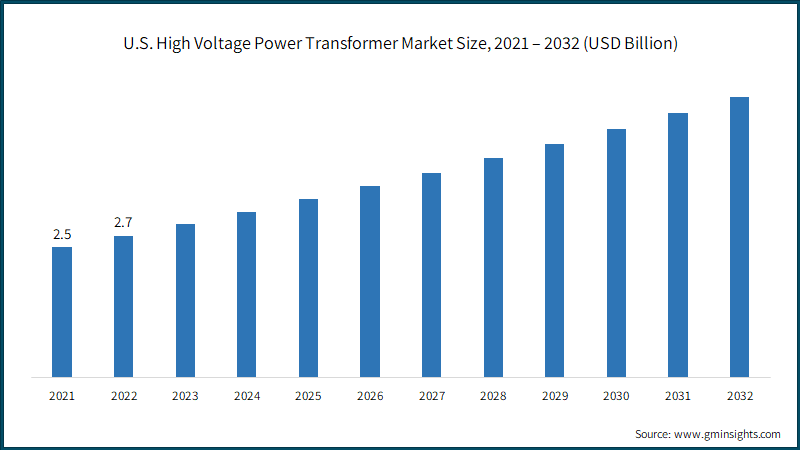Home > Energy & Power > Electrical Equipment > Transformers > High Voltage Power Transformer Market
High Voltage Power Transformer Market Analysis
- Report ID: GMI6600
- Published Date: Aug 2023
- Report Format: PDF
High Voltage Power Transformer Market Analysis
Based on cooling, the high voltage power transformer market is segmented as dry type and oil immersed. The dry type segment is set to grow at a CAGR of more than 7.8% through 2032. The safety advantages of dry-type transformers over oil-immersed transformers stem from their non-flammable and self-extinguishing insulation materials. In response to growing safety and environmental considerations, the market for dry-type transformers has experienced a surge in demand. This trend is driven by the elimination of the risks associated with oil leakage and its potential hazards. Additionally, the increasing integration of renewable energy sources such as solar and wind power into the electrical grid has further fueled the demand for dry-type transformers.
Based on voltage rating, the high voltage power transformer market is segmented as SPT (≤ 60 MVA) and LPT (> 60 MVA). The LPT (> 60 MVA) segment is held a majority market share of over 90% in 2022. The growing necessity for the modernization of power grids and the replacement of aging infrastructure is propelling the demand for large power transformers (LPTs). Governments and utility companies are making substantial investments in projects aimed at expanding and improving grid reliability, thereby stimulating the LPT market. The surge in worldwide electricity consumption, particularly in emerging economies, is driving the requirement for additional power generation and transmission capabilities, consequently boosting the demand for LPTs.
Furthermore, the integration of renewable energy sources into the grid necessitates efficient power transmission and distribution, a role where large power transformers are indispensable in connecting renewable energy facilities to the grid.

Based on application, the high voltage power transformer market is segmented as commercial, industrial, and utility. The utility segment held the majority market value of more than USD 13.5 billion in 2022. The growing uptake of renewable energy sources, including solar and wind power, in large-scale utility projects is a key driver behind the rising demand for high voltage power transformers. These transformers are indispensable for converting and transmitting electricity generated from renewable sources to the electrical grid. Utility companies are making substantial investments in grid modernization and expansion endeavors, aimed at boosting the efficiency and reliability of power transmission. Within these initiatives, utility-scale high voltage power transformers are being deployed to accommodate the increased power demand and enhance grid stability.
The utility-scale high voltage power transformers market is also being influenced by the integration of smart grid technologies. Smart grid systems demand advanced monitoring, control, and communication capabilities, which are effectively facilitated by intelligent high voltage transformers.

North America high voltage power transformer market has witnessed a growth rate of over 6.3% between 2023 and 2032. In North America, particularly in the United States and Canada, there has been a notable uptick in the demand for electrical products, driven by increased investments in the development of extensive long-distance transmission networks. In recent years, the emergence of public-private partnerships (PPPs) has emerged as a pivotal financing mechanism for electrical infrastructure projects in the region. These partnerships have played a pivotal role in supporting the expansion of power networks and are poised to continue creating favorable conditions for businesses in the industry.
The power sector is poised for further expansion due to the combination of increasing financial resources and a growing number of public and private collaborations. This trend is set to create a positive outlook for enterprises operating in the electrical products market. Additionally, there is a growing emphasis on replacing conventional electrical equipment with advanced, state-of-the-art systems, a shift that will contribute to heightened demand for products throughout the region.

